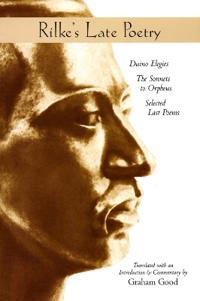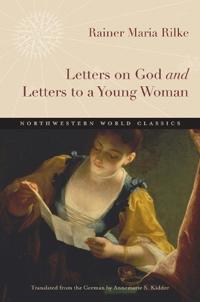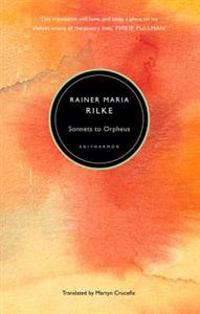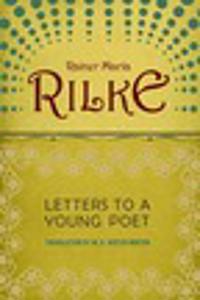Rilke's Late Poetry (Häftad)
avRainer Rilke
ISBN: 9781553800248 - UTGIVEN: 2005-03The late poetry of Rainer Maria Rilke (1875-1926) is one of the summits of European poetry in the twentieth century. Completed in 1922, as were T S Eliots The Waste Land and James Joyces Ulysses, Duino Elegies ranks with them as a classic of literary Modernism and as an inquiry into the spiritual cr[...]
Rilke on Love and Other Difficulties (Pocket)
avRainer Maria Rilke, John J. L. Mood, Rainer Maria Rilke
ISBN: 9780393310986 - UTGIVEN: 199402This is a mini-anthology of Rilke's poetry and prose for both aficionados and newcomers. Combining great passion and gentle care, the poems on love presented here are often not only sensual but explicitly sexual as well. Others reflect perennial themes in Rilke's work - death and life, growth and tr[...]
Rainer Maria Rilke's The Book of Hours (Häftad)
avRainer Maria Rilke
ISBN: 9781571135438 - UTGIVEN: 2012-07Rainer Maria Rilke is arguably the most important modern German-language poet. His New Poems, Duino Elegies, and Sonnets to Orpheus are pillars of 20th-century poetry. Yet his earlier verse is less known. The Book of Hours, written in three bursts between 1899 and 1903, is Rilke's most formative wor[...]
The Essential Rilke (Häftad)
avGalway Kinnell, Rainer Maria Rilke
ISBN: 9780060956547 - UTGIVEN: 200009German poet Rainer Maria Rilke(1875-1926) enjoys ever-increasing popularity. His Duino Elegies is considered on of the greatest long poems of the twentieth century. Yet translations from his native German have always presented challenges: the elusiveness of Rilke's imagery, the playful way he both d[...]
The Poetry of Rilke (Häftad)
avRainer Maria Rilke, Adam Zagajewski
ISBN: 9780374532710 - UTGIVEN: 2011-03Rilke: New Poems (Inbunden)
avRainer Maria Rilke, Robert Hass
ISBN: 9781556594243 - UTGIVEN: 2014-02"Essential for all poetry collections...Originally published in 1907 and 1908 in two volumes, the 200 poems contained in this bilingual single volume represent a period of intense creativity in the poet's career. Translator Joseph Cadora renders a beautiful new edition complete with commentary on ea[...]
Rilke's Book of Hours: Love Poems to God (Häftad)
avRainer Maria Rilke
ISBN: 9781594481567 - UTGIVEN: 2005-11A special anniversary edition featuring the complete English and German texts, this collection of poetry, based on the Book of Hours--psalms and prayers for various times throughout the day--used by monks, offers prayers and songs that address such concerns as spirituality in the modern age and the [...]
Pilgrimsboken. Rainer Maria Rilkes poesi i tolkning av Anders Frostenson (Inbunden)
avRainer Maria Rilke
ISBN: 9789163113253 - UTGIVEN: 200212Rainer Maria Rilkes poesi tillhör världslitteraturen. I trilogin Das Stunden-Buch samlade Rilke under åren 1899-1905 de poem som kallats "kärleksbrev till Gud".
Pilgrimsboken är andra delen. Den utkom 1979 på svenska i tolkning av Anders Frostenson.
Edition Diadorims utg[...]Selected Poems: Bilingual Edition (Övrig)
avRainer Rilke
ISBN: 9780520229259 - UTGIVEN: 2001-05-16These poems, selected from Das Buch der Bilder and the two parts of Neue Gedichte, show Rilke's deep concern with sculpture and painting. Written in his less mystical period (1900-1908), the poems exhibit Rilke's particular artistic and poetic power. Rainer Maria Rilke was one of Germany's most im[...]
Letters on God and Letters to a Young Woman (Häftad)
avRainer Rilke
ISBN: 9780810127401 - UTGIVEN: 2012-05Rainer Maria Rilke (1875-1926) was an avid letter writer, and more than seven thousand of his letters have survived. The best-known collection today is Rilke's Letters to a Young Poet, first published in 1929. Two other letter collections appeared around the same time and gained high acclaim among r[...]
The Notebooks of Malte Laurids Brigge (Pocket)
avRainer Maria Rilke, Burton (TRN) Pike, Rainer Maria Rilke
ISBN: 9781564784971 - UTGIVEN: 2008-10First published in 1910, Rilke's Notebooks of Malte Laurids Brigge is one the first great modernist novels, the account of poet-aspirant Brigge in his exploration of poetic individuality and his reflections on the experience of time as death approaches. This new translation by Burton Pike is a reac[...]
Sonnets to Orpheus (Pocket)
avRainer Maria Rilke, Martyn (TRN) Crucefix, Rainer Maria Rilke
ISBN: 9781907587221 - UTGIVEN: 2013-01In fifty-five sonnets, Rilke plays an astonishing set of philosophical and sensual variations on the Orpheus myth. 'Praising, that's it!' he declares; nature, art, love, time, childhood, technology, poverty, justice - all are encompassed in poems that spark with insight and invention, amongst the jo[...]
Selected Poems of Ri (Häftad)
avRainer Maria Rilke, Robert W. Bly
ISBN: 9780060907273 - UTGIVEN: 1981-04For poetry lovers and students of literature and literary criticism, a National Book Award-winning poet brings his prowess as a translator and critic to bear on the work of one of the major German poets of the century.[...]
The Notebooks of Malte Laurids Brigge. (Storpocket)
avRainer Maria Rilke
ISBN: 9780141182216 - UTGIVEN: 200906While his old furniture rots in storage, Malte Laurids Brigge lives in a cheap room in Paris, with little but a library reader's card to distinguish him from the city's untouchables. Every person he sees seems to carry their death with them, and he thinks of the deaths, and ghosts, of his aristocrat[...]
Letters to a Young Poet (Häftad)
avRainer Maria Rilke
ISBN: 9780141192321 - UTGIVEN: 201204At the start of the twentieth century, Rainer Maria Rilke wrote a series of letters to a young officer cadet, advising him on writing, love, sex, suffering and the nature of advice itself; these profound and lyrical letters have since become hugely influential for writers and artists of all kinds. T[...]
Selected Poems (Pocket)
avRilke, Rainer Maria
ISBN: 9780199569410 - UTGIVEN: 2011-04-14Rilke is one of the leading poets of European Modernism, and one of the great twentieth-century lyric poets in German. From The Book of Hours in 1905 to the Sonnets of Orpheus written in 1922, he constantly probed the relationship between his art and the world around him, moving from the neo-romanti[...]
Duino Elegies & the Sonnets to Orpheus (Häftad)
avRainer Maria Rilke
ISBN: 9780307473738 - UTGIVEN: 200910Selected Poetry of Rainer Maria Rilke
ISBN: 9780307787545 - UTGIVEN: 2015-06This miracle of a book, perhaps the most beautiful group of poetic translations this century has ever produced, (Chicago Tribune) should stand as the definitive English language version.From the Trade Paperback edition.[...]
Letters of Rainer Maria Rilke, 1910-1926 (häftad)
ISBN: 9780393004779 - UTGIVEN: 1969-02There are important letters here to Muzot, Lou Andreas-Salome, to Princess Marie of Thurn and Taxis Hohenlohe, and many others. The most significant of the Wartime Letters: 1914-1921 are also included. An Introduction briefly traces the development of Rilke's work during these years; the Notes provi[...]
Rainer Maria Rilke And Lou Andreas-salome
ISBN: 9780393049763 - UTGIVEN: 2006-06He would become one of the most important poets of the twentieth century; she was the uber-muse of Europe's turn-of-the-century thinkers and artists. In this never-before-translated collection of letters spanning almost thirty years, the poet Rainer Maria Rilke and Lou Andreas-Salome, a writer and i[...]
Letters to a Young Poet (Pocket)
avRainer Maria Rilke, M. D. Herter Norton, Franz Xaver Kappus
ISBN: 9780393310399 - UTGIVEN: 199312Drawn by some sympathetic note in one of his poems, young people often wrote to Rilke with their problems and hopes. From 1903 to 1908 Rilke wrote a series of remarkable responses to a young would-be poet, on poetry and on surviving as a sensitive observer in a harsh world. An accompanying chronicle[...]
Duino Elegies (Häftad)
avRainer Maria Rilke
ISBN: 9780393328844 - UTGIVEN: 200606We have a marvelous, almost legendary, image of the circumstances in which the composition of this great poem began. Rilke was staying at a castle (Duino) on the sea near Trieste. One morning he walked out on the battlements and climbed down to where the rocks dropped sharply to the sea. From out of[...]
Letters to a Young Poet (Häftad)
avRainer Maria Rilke
ISBN: 9780394741048 - UTGIVEN: 198610Letters written over a period of several years on the vocation of writing by a poet whose greatest work was still to come.[...]



























